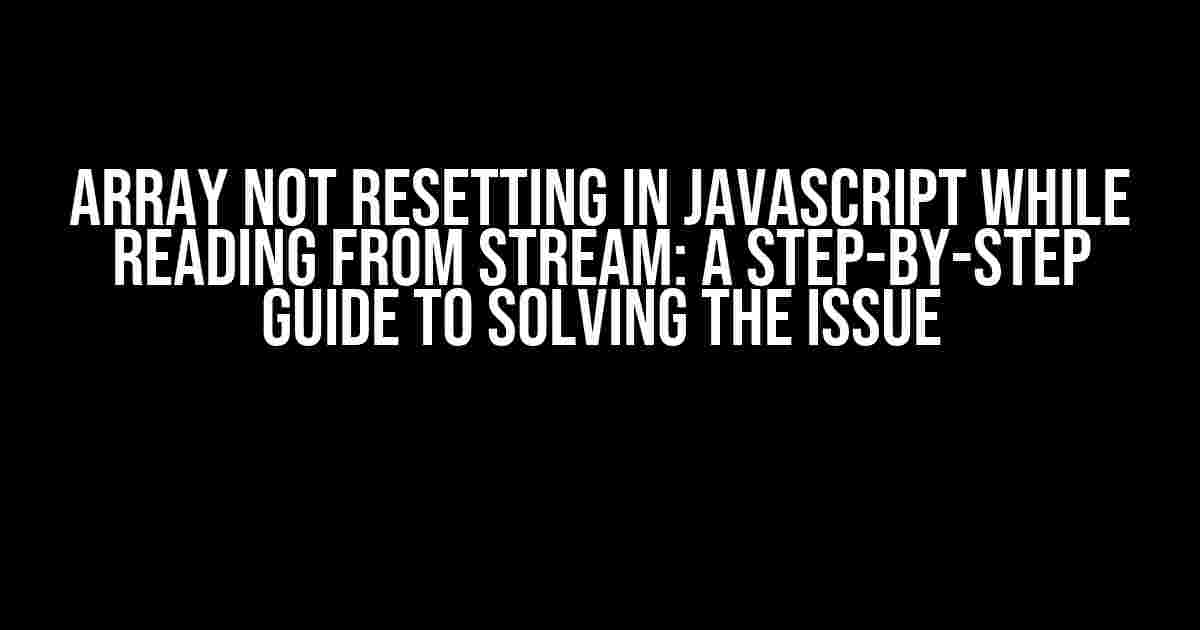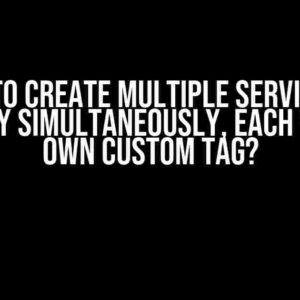Introduction
Are you tired of struggling with arrays that refuse to reset in JavaScript while reading from a stream? You’re not alone! This frustrating issue has plagued many developers, but fear not, dear reader, for we’re about to embark on a journey to conquer this pesky problem once and for all.
Understanding the Problem
When working with streams in JavaScript, it’s not uncommon to encounter an array that refuses to reset its values. This can occur when you’re trying to read data from a stream and store it in an array, only to find that the array retains its previous values.
But why does this happen? Well, it’s largely due to the way JavaScript handles arrays and streams. You see, when you create an array in JavaScript, it’s initialized with a reference to a specific memory location. When you read data from a stream into an array, the array’s reference remains the same, even if you reassign new values to it.
Symptoms of the Issue
So, how do you know if your array is not resetting properly? Here are some common symptoms to look out for:
- The array retains its previous values even after reinitializing it.
- New values are appended to the existing array instead of replacing the old ones.
- The array’s length property remains the same even after reassigning new values.
Causes of the Issue
Now that we’ve identified the symptoms, let’s dive into the causes of this issue:
- Reusing the same array reference: As we mentioned earlier, arrays in JavaScript are initialized with a reference to a specific memory location. If you reassign new values to the same array reference, it will retain its previous values.
- Failing to clear the array properly: If you don’t clear the array properly before reassigning new values, it will still hold onto its previous values.
- Using the wrong method to read from the stream: The method you use to read from the stream can also affect how the array is populated. For example, using the
readLine()method can cause the array to retain its previous values.
Solutions to the Issue
Now that we’ve covered the causes of the issue, let’s dive into the solutions!
Solution 1: Create a New Array Reference
One of the simplest ways to resolve this issue is to create a new array reference every time you read from the stream. Here’s an example:
const stream = fs.createReadStream('data.txt');
const array = [];
stream.on('data', (chunk) => {
const newArray = []; // Create a new array reference
newArray.push(chunk);
console.log(newArray); // This will log a new array with the latest chunk
});
Solution 2: Clear the Array Properly
Another solution is to clear the array properly before reassigning new values. You can use the length property to clear the array:
const stream = fs.createReadStream('data.txt');
let array = [];
stream.on('data', (chunk) => {
array.length = 0; // Clear the array
array.push(chunk);
console.log(array); // This will log a cleared array with the latest chunk
});
Solution 3: Use the Right Method to Read from the Stream
The method you use to read from the stream can also affect how the array is populated. Instead of using the readLine() method, try using the read() method to read the entire stream into a buffer:
const stream = fs.createReadStream('data.txt');
let array = [];
stream.on('data', (chunk) => {
array.push(chunk);
});
stream.on('end', () => {
const buffer = Buffer.concat(array);
console.log(buffer.toString()); // This will log the entire stream contents as a string
});
Best Practices to Avoid the Issue
To avoid this issue altogether, follow these best practices:
- Always create a new array reference when reading from a stream.
- Clear the array properly using the
lengthproperty or thesplice()method. - Use the right method to read from the stream, such as the
read()method. - Avoid reusing the same array reference across multiple reads from the stream.
Conclusion
And there you have it, folks! With these solutions and best practices, you should be able to resolve the issue of arrays not resetting properly while reading from a stream in JavaScript.
Remember to create new array references, clear the array properly, and use the right method to read from the stream. By following these guidelines, you’ll be well on your way to becoming a JavaScript master!
| Solution | Description |
|---|---|
| Create a new array reference | Create a new array reference every time you read from the stream. |
| Clear the array properly | Clear the array using the length property or the splice() method. |
| Use the right method to read from the stream | Use the read() method to read the entire stream into a buffer. |
We hope this article has been informative and helpful in resolving the issue of arrays not resetting properly while reading from a stream in JavaScript. Happy coding!
Frequently Asked Question
Get answers to your most pressing questions about arrays not resetting in JavaScript while reading from streams.
Why does my array not reset when I’m reading from a stream in JavaScript?
This is because JavaScript arrays are passed by reference, not by value. When you assign a new array to a variable, you’re not creating a new array, but rather a new reference to the same array. To reset the array, you can use the `splice()` method to remove all elements, or reassign the variable to a new array literal `[]`.
How do I prevent my array from being modified when reading from a stream?
One way to prevent array modification is to create a copy of the array using the spread operator `…` or the `slice()` method. This will create a new array with the same elements, but any changes made to the copy will not affect the original array.
Can I use the `delete` operator to remove elements from my array when reading from a stream?
No, using the `delete` operator will not remove elements from the array, but rather set the element to `undefined`. To remove elements, use the `splice()` method or the `filter()` method to create a new array with the desired elements.
Why does my array still have the old values after I’ve reassigned it?
This is likely due to the asynchronous nature of stream reading. Make sure to reassign the array within the callback function or promise resolution, and not outside of it. This ensures that the array is reassigned after the stream has finished reading.
How do I debug array issues when reading from a stream?
Use the browser’s developer tools to inspect the array values and variables. You can also add console logs or debuggers to trace the array modifications and identify where the issue occurs. Additionally, use the `console.table()` method to visualize the array contents and identify any unexpected values.









